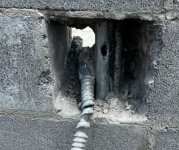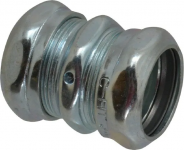Electromatic
Senior Member
- Location
- Virginia
- Occupation
- Master Electrician
I had to repair a piece of damaged EMT in a chipped-out single cell of CMU and had a heck of a time finding anyone with slip couplings in stock. As necessity is the mother of invention, I grabbed some regular couplings from the warehouse and started head-scratching. Just a few minutes of drilling out the three dimples in a compression coupling...voila! slip coupling. The ones I had on hand were Crouse Hinds, but it looks like Steel City also uses the dimples.

 Thought I'd share in case someone else ends up in a bind.
Thought I'd share in case someone else ends up in a bind.

 Thought I'd share in case someone else ends up in a bind.
Thought I'd share in case someone else ends up in a bind.
